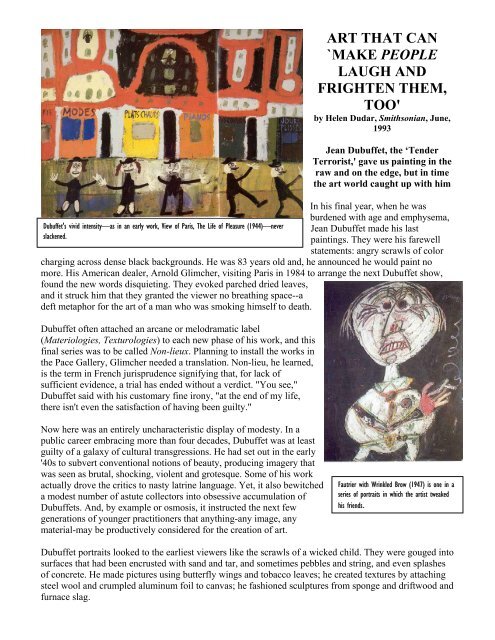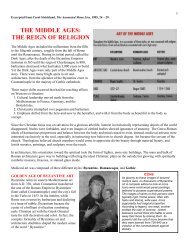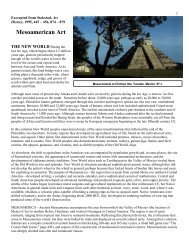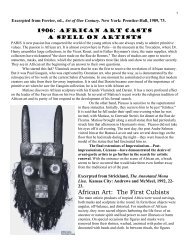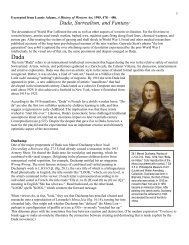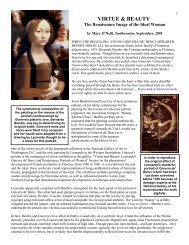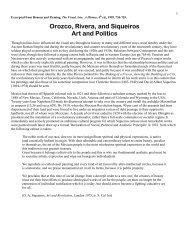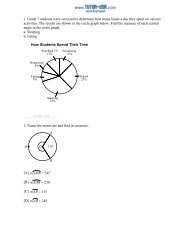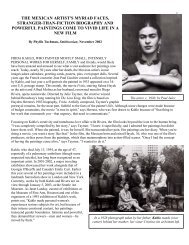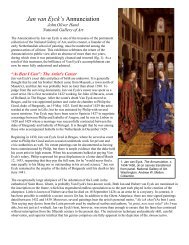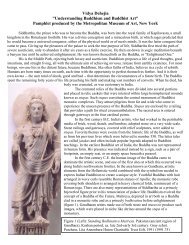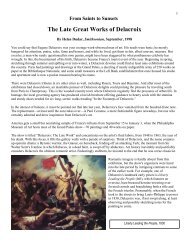Dubuffet, Art that can make people laugh.pdf - Phs.poteau.k12.ok.us
Dubuffet, Art that can make people laugh.pdf - Phs.poteau.k12.ok.us
Dubuffet, Art that can make people laugh.pdf - Phs.poteau.k12.ok.us
- No tags were found...
You also want an ePaper? Increase the reach of your titles
YUMPU automatically turns print PDFs into web optimized ePapers that Google loves.
intimates among Paris' men of letters to write admiring articles describing him affectionately as "<strong>Dubuffet</strong>the Terrible" and the "Tender Terrorist." He repaid their support by making them look awful on <strong>can</strong>vas.In his whimsical 1946 painting Touring Club, <strong>Dubuffet</strong> was reportedto have shown himself as the hood ornament. When asked if thiswas true, he answered, "Yes, now you <strong>can</strong> see whether I am agood artist or not."Almost inevitably, <strong>Dubuffet</strong> the rule-bender was theproduct of a serio<strong>us</strong>, bourgeois family rooted in LeHavre and devoted to the domestic comforts providedby a thriving wholesale trade in wines and liquors. Heonce told an Ameri<strong>can</strong> journalist <strong>that</strong> he hated his"merchant family," and he appeared to have eventuallysevered relations with them. When he was well intohis late years, <strong>Dubuffet</strong> traveled to Le Havre to inspecta m<strong>us</strong>eum retrospective of his work and, as herounded a corner of a gallery, encountered anextremely elderly woman examining a painting. Thewoman turned out to be his mother, then not far fromher hundredth birthday; they had not met for years. Ashe related to Glimcher, they had a "very niceconversation." Then he went back to Paris and neversaw her again,<strong>Dubuffet</strong> had left home at 17 to study art in Paris;dissatisfied with formal instruction, he abandoned school within months and gave up painting completelya few years later. In the next quarter of a century he traveled abroad; got married, fathered a daughter andwas divorced; launched and abandoned a couple of wholesale wine b<strong>us</strong>inesses; and took up and stoppedpainting a second time. Finally, in 1942 at the age of 41, he decided <strong>that</strong> he wanted to spend his lifecreating art. A man of formidable intelligence, an autodidact, <strong>Dubuffet</strong> had also, by then, learned his wayinto most of the arts. He wrote with professional skill, and he seemed to acquire languages with the easeof a gardener gathering flowers. For a period in the late '40s he made several painting expeditions to theSahara Desert, and to smooth his sojourns applied himself successfully to learning Arabic.As a <strong>make</strong>r of and writer on art, <strong>Dubuffet</strong> was a worldclasscontrarian, a killer iconoclast. He was anti-academy, antiestablishment,anti-history—in short, irrevocably opposed tocultural traditions as the Western world defined them. Painting, heargued, required neither schooling nor inborn talent. "Everybodyin the world is a painter." Drawing from life was stupid. Mostaccepted work, including contemporary avant-garde art, washardly worth looking at: "It suffers from being a ho<strong>us</strong>e plant ...made by and for ... initiates." In what was a sketchy but aptdescription of the impact of some of his own work, he wrote, "<strong>Art</strong>should always <strong>make</strong> <strong>people</strong> <strong>laugh</strong> a little and frighten them alittle."Pridefully, <strong>Dubuffet</strong> insisted <strong>that</strong> he never visited m<strong>us</strong>eums orgalleries, although he seemed to know everything worth knowingabout art of the past. When he did break his rule and visit theGuggenheim, Messer remembers, he walked past a wall ofsomeone else's paintings with one hand shielding his eyes from theoffending sight. He did find a few contemporaries acceptable. Heapproved of Claes Oldenburg, who, in his earliest work, was anunabashed devotee of <strong>Dubuffet</strong>ism. But what most excited<strong>Dubuffet</strong> was art <strong>that</strong> he saw snaking along the borders ofBody of a Lady Rose Incarnate is an assault on theWestern tradition of the female nude—not on women.
clung to the cheese-paring habits of wartime France. A pair of visiting teenage sons of Ameri<strong>can</strong> friendswere treated to charm and lunch in the elegant court garden of his ho<strong>us</strong>e on the rue Vaugirard; the foodwas served with a wine <strong>that</strong> <strong>Dubuffet</strong> actually boasted was vin ordinaire, the cheapest vintage, whichho<strong>us</strong>eholders bought by carrying bottles for refills to the neighborhood wine merchant. On one visit,Morton Janklow was astonished to discover <strong>that</strong> this successful artist drove a Deux Chevaux, the toylikechug-chug vehicle <strong>that</strong> the least-monied Frenchman acquired when trading up from a bicycle.On the other hand, expense was never spared for the creation of art. In addition to the work space in hishome, there were several other studios both in Paris and outside the city. Moreover, <strong>Dubuffet</strong> left nothingto chance. Catalogues raisonnes, summaries of a life's work, are <strong>us</strong>ually posthumo<strong>us</strong> affairs. In the '60s,<strong>Dubuffet</strong> set about arranging his posterity: two full-time employees tended a record of every piece he hadever made, and a Belgian scholar, Max Loreau, was assigned the job of organizing the effort and writingessays. In <strong>Dubuffet</strong>'s lifetime, there would be 37 volumes—somewhat pretentio<strong>us</strong>ly called fascicules—with dated photographs of all his work or blank spaces denoting missing pieces. There would also beoccasional comments by the artist, lists of owners of his art and, most engaging of all, snippets of pressreviews neatly balanced between praise and vicio<strong>us</strong> insult.Even victims of his need to controlcould not help admiring his steelyresolve. When Tom Messer waspreparing the Guggenheim show <strong>that</strong>would also travel to the GaleriesNationales du Grand Palais in Paris,<strong>Dubuffet</strong> had to be cajoled intocooperating. For him, the work of themoment was always more interestingthan last year's art. Midway in thelong preparatory period, he wrote totell Messer <strong>that</strong> he had begun aproject <strong>that</strong> he wanted included in theshow. No problem, Messer said,innocent of what the future held.Gradually he learned it was a theaterpiece called Coucou Bazar, and <strong>that</strong> itwould require stage sets, performers incostume, an acre of additional spaceand a bundle of money—about doublewhat was already an unmanageablebudget.With ten-foot-wide Tide of Hourloupe (1963) and other works in the Hourloupe series,<strong>Dubuffet</strong> moved into big panels. The interlocking hard-edged design, like a giant jigsaw puzzle,grew out of doodles on a notepad.Messer was finally to understand <strong>that</strong> in any conflict, <strong>Dubuffet</strong> required—actually, demanded—victory."Ever so politely, in his exquisite French manner, he put before me an unstated ultimatum. Either you dothe first Coucou Bazar in its fullness together with the show or the show is off." Coucou Bazar ran on<strong>Dubuffet</strong>'s terms, and Messer, who had always been an admirer of the artist's, actually managed to forgiveif not to forget the grief it ca<strong>us</strong>ed him and his French colleagues.The Hirshhorn exhibition stops at the start of a new cycle for which the Bazar sets and costumes were aclimax of sorts. The last three pieces in Demetrion's show are paintings in the style <strong>Dubuffet</strong> calledHourloupe, an invented word <strong>that</strong> someone once noted resembled entourloupette—"swindle" in Frenchslang. The designs were high-concept doodles, interlocking cells in three colors—red, blue and black—pl<strong>us</strong> white, <strong>us</strong>ually with stripes running in different directions. Although the work looked abstract,imagery was often hidden in a piece. In good time, Hourloupe graduated from easel works to extremely


